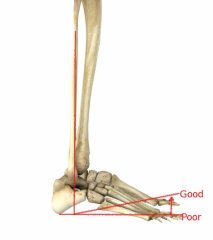It has been said that there is a “Direct Correlation Between the Athlete’s Ability to Fire their Glutes and Dorsiflex their Ankle.” The science hasn’t completely caught up with the neurological firing sequences that take place, but the clinical and biomechanical components are undeniable.
 To first review what we’re talking about, ankle dorsiflexion is an athlete’s ability to pull their toe towards their shin. Ideally, an athlete will demonstrate at least 10-15 degrees of Dorsiflexion, but unfortunately, many of them struggle greatly with this motion, especially if they have sustained a previous ankle or lower extremity injury. In fact, poor ankle dorsiflexion is likely the most overlooked and under appreciated component of a lower extremity evaluation, regardless of where the pain or injury site may be.
To first review what we’re talking about, ankle dorsiflexion is an athlete’s ability to pull their toe towards their shin. Ideally, an athlete will demonstrate at least 10-15 degrees of Dorsiflexion, but unfortunately, many of them struggle greatly with this motion, especially if they have sustained a previous ankle or lower extremity injury. In fact, poor ankle dorsiflexion is likely the most overlooked and under appreciated component of a lower extremity evaluation, regardless of where the pain or injury site may be.
The importance of quality glute firing is well documented. The glutes are likely the most explosive and important muscle of the lower body. Without strong and active glutes, an athlete will struggle to produce power, stabilize their core, prevent knee injuries, or even balance on a single leg. So, if an athlete struggles to dorsiflex their ankle, it is usually a given that their glutes aren’t working well.
What is the relationship?
Biomechanically, it is fairly easy to see the relationship. The best way to see good glute firing is to put the athlete in a position where they can easily reach full hip extension. While we would like to see 15-20 degrees of hip extension in all athletes, it will vary greatly depending upon Illiopsoas tightness.
In a clinical setting, the glutes can be isolated with the knee bent, especially when lying prone (on their stomach). But, this is not functional at all and does very little to replicate sporting movement patterns.
By telling the athlete to shift their weight to their heels and dorsiflex when given the opportunity, we begin to see better glute firing. This is especially true with the athlete weight-bearing (as in an acceleration position). By dorsiflexing and driving through the heel, the athlete will automatically lock their knee into extension, squeeze the quads and the glutes will fire. By cuing your athletes to dorsiflex and drive through their heels with weight-bearing exercises, it won’t take long for your to see that this simple coaching point will go a long way to help your athletes produce power and prevent injury.
Neural Component
To say that the research in this area is limited is overstating it. To date, it is difficult to scientifically say for sure that there is a direct neurological track between an athlete’s ankle dorsiflexors and glutes. But, it is pretty easily deduced that there is some sort of a neurological connection between the two. After all, the nervous system controls everything within the body.
Treatment
Usually, cuing anc coaching will do wonders to improve this relationship. But, if the athlete has a history of ankle issues and has a true ankle dorsiflexion restriction, hands on work will likely be required to get rid of scarring and adhesions. This will include a variety of joint mobs, which is above and beyond the scope of this discussion.
Looking for more help? Schedule a consultation today!


Leave a Reply